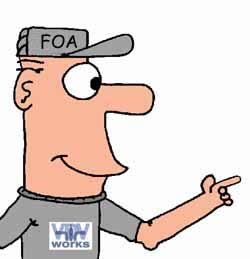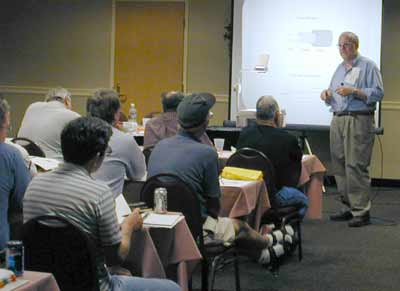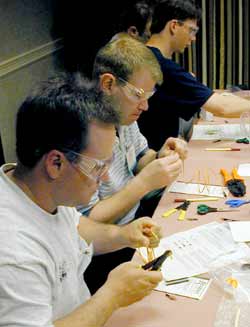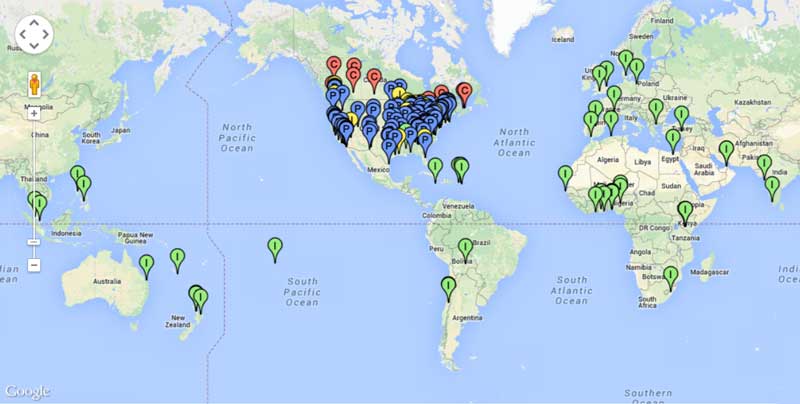
- Lennie Lightwave's
- Guide To Fiber Optics
Training
Getting More Training
Now that Lennie's Guide has provided you with the basics, you're probably ready to figure out where to go from here. We've been training fiber techs for over 30 years, so we have some strong opinions on the subject. About half the world comes here to Lennie to get started! Then they go to The FOA to get trained and certified.
There are many options for further training but first you need to figure out what your career choice is.
If you want to work in engineering for a component manufacturer, you will need to learn the theory behind the technology, so you will probably need to start with university level classes in physics and add classes in electronics, optics and fiber optics. If you want to design networks, you probably need a university education in electronics and communications system design.
If you just want to understand the technology so you can design, install and maintain cable plants and networks for LANS, CATV systems, utilities, etc. you need to know very little about the theory itself, but lots about cables, connectors and hardware and how cable plants are designed, installed and tested. Your training should focus on practical knowledge and lots of hands-on exercises. Work toward getting your Certified Fiber Optic Technician certification from The FOA.
Whatever your interest, make sure the courses you take are appropriate for your interests or you'll be wasting time and money. Here are some options to consider:

Seminars
Seminars can run from one day to two weeks and cost nothing to several thousand dollars. Make sure any seminar you attend is focused on what aspect of fiber optics you want to learn and has lots of hands-on exercises. Also remember that company-sponsored seminars can be narrowly focused on their products only. If you plan on using this equipment it can be a real deal!
Continuing Education
Technical schools are now offering cable installation courses, usually one or two nights a week for ten to twelve sessions. The big advantage of these courses is the extra time involved, usually more than twice as much as would be available in a seminar. As a result, you get more time to ask questions, practice hands-on lessons seminars. And if classes are in the evening, you do not have to take days off work for class.
Self Study Programs
Some of us just learn better on our own. A well organized self-study program will help us learn new technologies like cable installation easily and quickly. A self-study program needs to have explanatory text, assignments and probably hands-on exercises to get the basic concepts across, and then recommendations for additional practicing to gain skills. VDV Works and The FOA have recreated the "Fiber U" free online training for those who like self-study.
Jim Hayes of VDV Works is the author of most of the most widely used books about fiber optics and cabling, the FOA Reference Guide to Fiber Optics, The FOA Reference Guide to Outside Plant Fiber Optics, FOA Reference Guide to Premises Cabling or the FOA Reference Guide To Fiber Optic Network Design. They are good reading for those interested in fiber optics and the Technicians Manual is the text used for the FOA CFOT exam.
Good videos can help too, like the FOA YouTube videos. Some videos are more entertainment than teaching, and they are sometimes out of date, but they can be helpful nonetheless.
Don't overlook online resources either. Lots of websites are like this one - chock-full of good technical informatIon for free!
What Makes a Good Cable Installation Seminar or Course ?
FOA instructors had lots of experience in running seminars, beginning in 1982 with one-day introductory seminars, in the 1990s running big training conferences for trade shows and major government and corporate clients nd for the 20 years of FOA, managing a network of hundred s of schools around the world. Our goal has always been to provide training that can help next week on the job.
s of schools around the world. Our goal has always been to provide training that can help next week on the job.
Classroom courses should give you a good back-ground on all the basics of cabling and all the components that make up a cabling network. Any premises cabling course should include a session on structured cabling standards as it applies to both fiber and copper cabling. Then in hands-on workshops, you should actually prepare cables, pull, terminate and test them. A good course offers lots of hands-on time so you really learn how to handle cabling components.
How can you find a good course to take?
The FOA has over 200 approved schools in 40 countries worldwide - here is a list and a map of current schools. Call some schools and ask for a brochure on their program and a current schedule. Also, get recommendations from students that have taken courses or talk to instructors in related fields. Training can be a big investment, so be thorough!

How can you get certification ?
Who certifies cabling technicians? Well, it seems every trainer, manufacturer and vendor offers a "certificate" to everybody who completes their class. None of them, of course, recognize the other's certificate and neither do most of your customers!
Fortunately, there is a professional society for fiber optics, The Fiber Optic Association, that offers certification to those who pass a qualifying test and can show related work experience. The FOA also approves training schools that meet their academic criteria. To be recognized as a professional in fiber optics, becoming a member of the FOA and passing certification exams is important..
